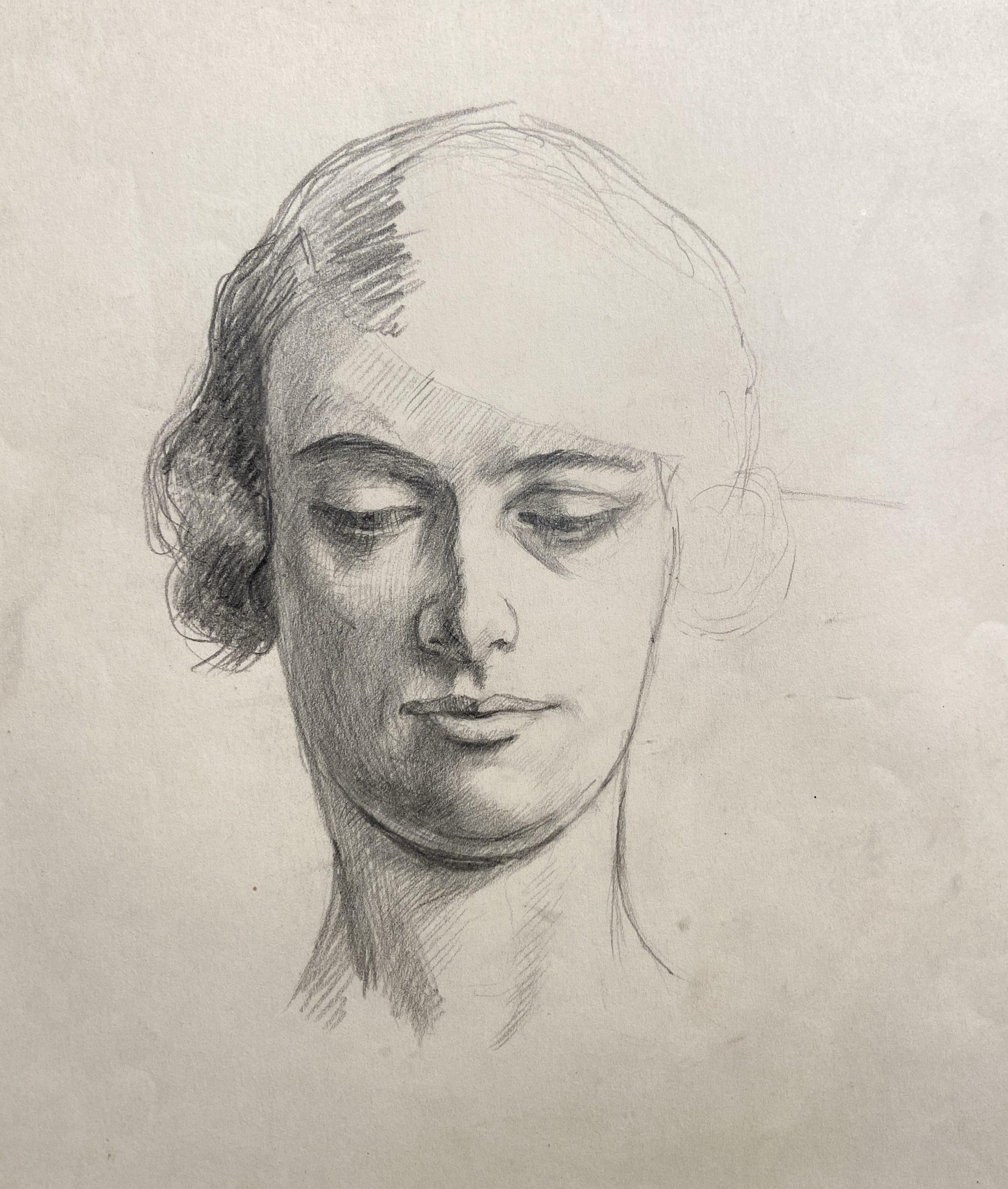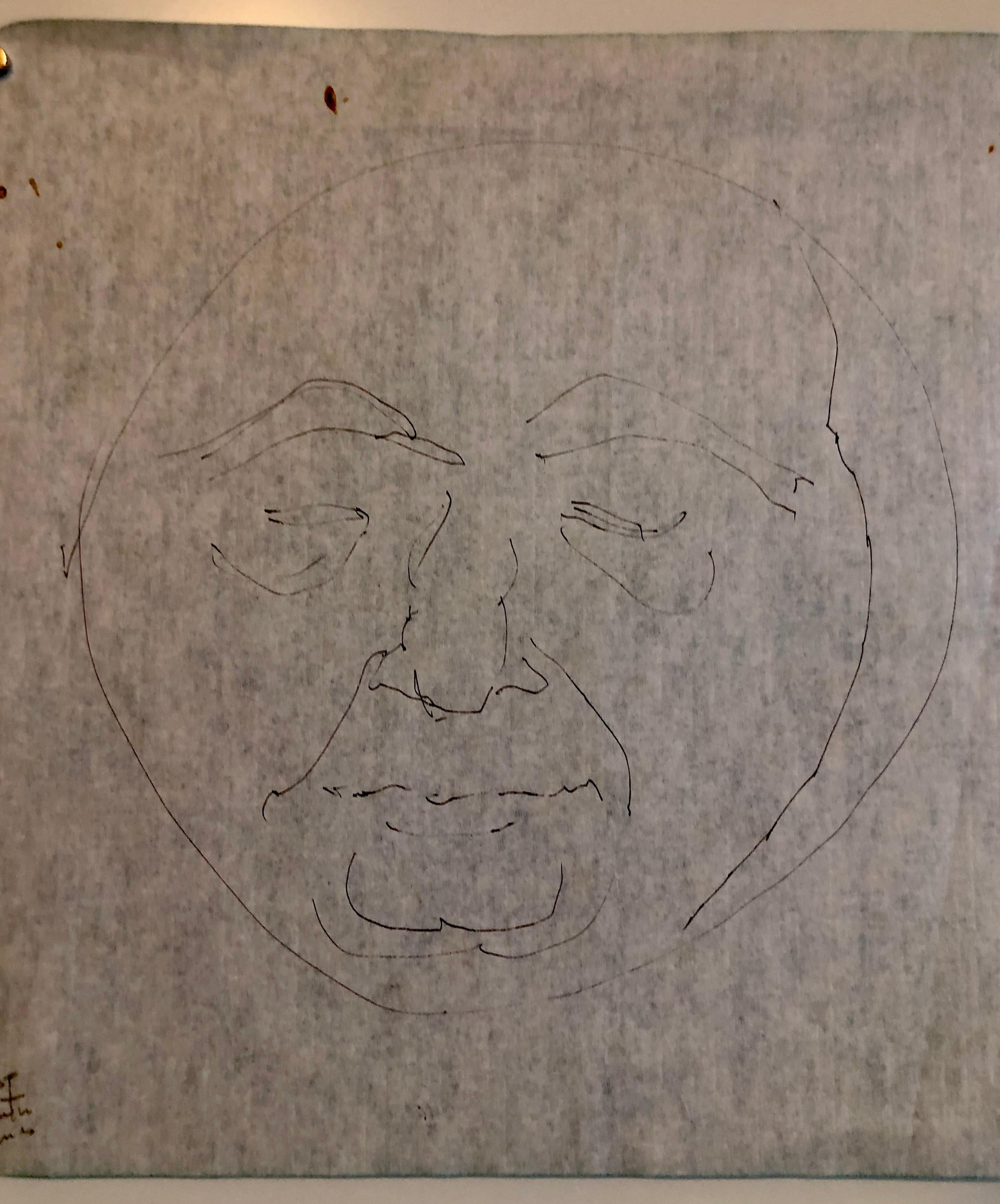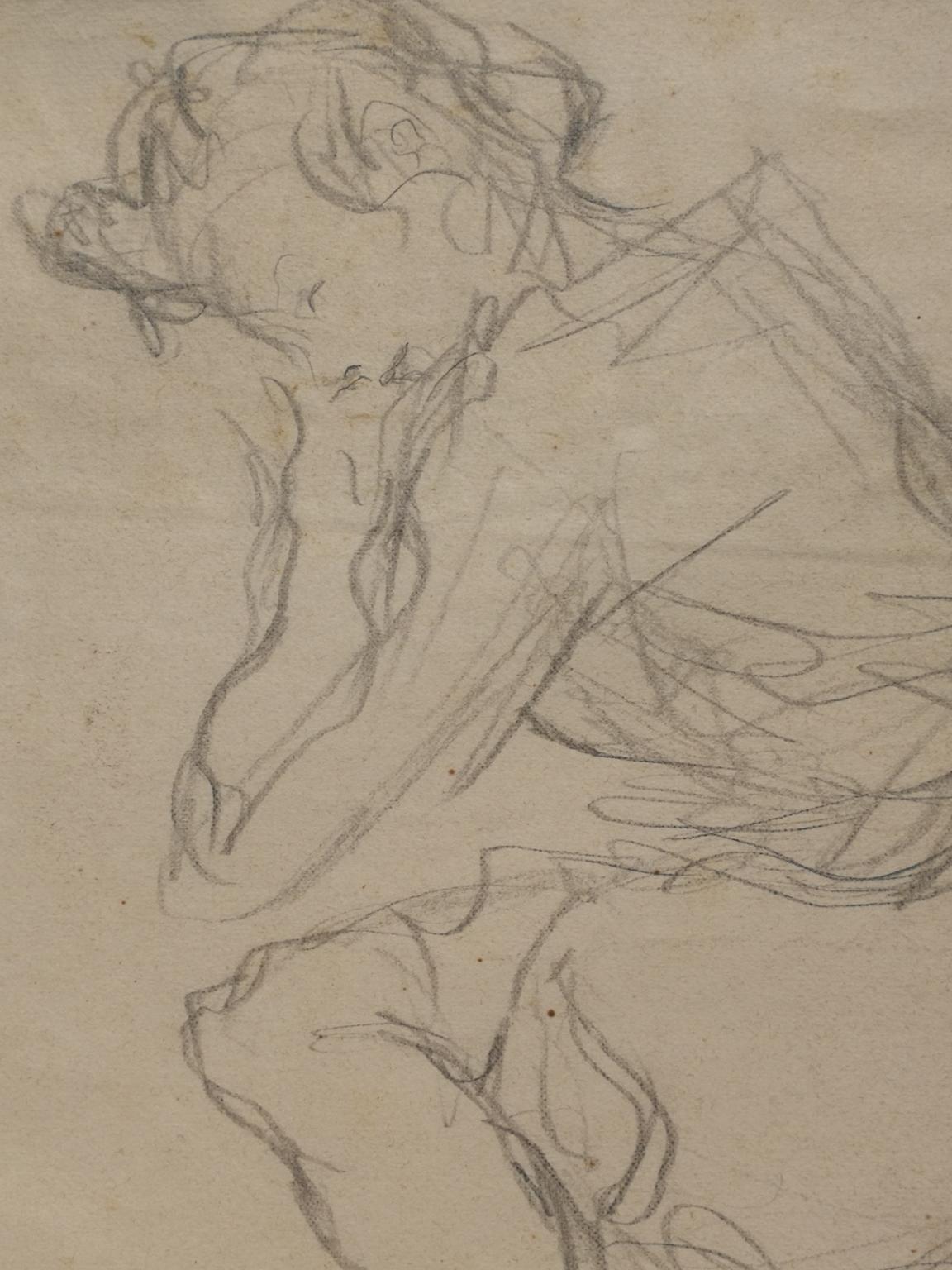Items Similar to Portrait - Original Drawing - 20th Century
Want more images or videos?
Request additional images or videos from the seller
1 of 2
UnknownPortrait - Original Drawing - 20th Century20th Century
20th Century
About the Item
"Portrait" is an original drawing in pencil on paper, realized by an Anonymous French Artist of the XX Century .
The state of preservation of the artwork is very good.
Sheet dimension: 17 x 19.2 cm.
The artwork represents beautiful child's portrait drawn in pencil.
On the back of the work another little defined portrait of a man, with a big nose and a signature at the bottom right.
- Creation Year:20th Century
- Dimensions:Height: 6.7 in (17 cm)Width: 7.56 in (19.2 cm)Depth: 0.04 in (1 mm)
- Medium:
- Movement & Style:
- Period:
- Framing:Framing Options Available
- Condition:Insurance may be requested by customers as additional service, contact us for more information.
- Gallery Location:Roma, IT
- Reference Number:
About the Seller
4.9
Platinum Seller
These expertly vetted sellers are 1stDibs' most experienced sellers and are rated highest by our customers.
1stDibs seller since 2017
6,693 sales on 1stDibs
Typical response time: 2 hours
- ShippingRetrieving quote...Ships From: Rome, Italy
- Return PolicyA return for this item may be initiated within 14 days of delivery.
More From This SellerView All
- Travelers - Original Drawing by Charles Joseph Traviès - Mid 19th CenturyBy Charles Joseph TravièsLocated in Roma, ITTravelers is an Original ink, pencil and watercolor realized by Charles Joseph Traviès (1804-1859). The little artwork represents two poor men in the street. Good condition, included a cream colored cardboard passpartout (30x24 cm). Hand-signed and notes by the artist on the lower margin. Charles-Joseph Traviès de Villers, also known simply as Traviès, (21 February 1804 – 13 August 1859) was a Swiss-born French painter, lithographer, and caricaturist whose work appeared regularly in Le Charivari...Category
Mid-19th Century Modern Figurative Drawings and Watercolors
MaterialsInk, Watercolor, Pencil
- Nude of Woman - Original Drawing by Alexandre Bida - Mid 19th CenturyLocated in Roma, ITNude of Woman is an Original pencil and white lead Drawing realized by Alexandre Bida (1823-1895). The artwork in good condition on a clue paper, inclu...Category
Mid-19th Century Modern Figurative Drawings and Watercolors
MaterialsPencil
- The Holy Family - Pencil Drawing By Maurice Chabas - Early 20th CenturyBy Maurice ChabasLocated in Roma, ITThe Holy Family is an Original Red Pencil Drawing realized by Maurice Chabas (1862-1947). The artwork is in good condition, included a white cardbo...Category
Early 20th Century Modern Figurative Drawings and Watercolors
MaterialsPencil
- Portrait of Pierre-Jean de Béranger - Original Drawing - Early 19th CenturyLocated in Roma, ITPortrait of Pierre-Jean de Béranger is an original drawing in Pencil realized in the Early 19th Century. Good conditions. The artwork is depicted through soft strokes in a well-bal...Category
Early 20th Century Modern Figurative Drawings and Watercolors
MaterialsPencil
- Figure of Man Pencil Drawing By Maurice Chabas - Early 20th CenturyBy Maurice ChabasLocated in Roma, ITFigure of Man is an Original Pencil Drawing realized by Maurice Chabas (1862-1947). The artwork is in good condition, included a white cardboard passpartout (37.5x55 cm). Monogramm...Category
Early 20th Century Modern Figurative Drawings and Watercolors
MaterialsPencil
- Old Man - Original Drawing by George Henry Harlow - 1818By George Henry HarlowLocated in Roma, ITOld Man is an Original Pencil Drawing realized by George Henry Harlow in 1818. The little artwork is on a yellowed paper, included a cream colored cardboard passpartout (36x26.5 cm)...Category
1810s Modern Figurative Drawings and Watercolors
MaterialsPencil
You May Also Like
- French Modern Drawing by Jean Hélion - Veil HommeBy Jean HélionLocated in Paris, IDFVeil Homme 1947 drawing 26,9 x 21 cm Registered on the catalogue raisonné with inventory number : N°0252 cat. B sold without frame about Jean Hélion (April 21, 1904 – October 27, 19...Category
1960s Modern Figurative Drawings and Watercolors
MaterialsPencil, Paper
- Portrait of a Woman Sitting in ProfileBy James StroudleyLocated in London, GBGraphite on paper Image size: 10 1/2 x 14 1/4 inches (26.5 x 36 cm) Mounted A fine pencil drawing and a stunning example of a 1930s Art Deco portrait.Category
1930s Modern Portrait Drawings and Watercolors
MaterialsGraphite
- Portrait of Alfred Hardiman, Graphite Sketch, Signed and Dated 1925Located in London, GBGraphite on paper, signed and dated Image size: 18 x 12 1/2 inches (46 x 32 cm) Mounted and framed The sitter for this portrait, Alfred Hardiman, was an English sculptor. Hardiman and Lyon were friends and met when they both attended the British School at Rome in the early 1920s. Hardiman won a London County Council Scholarship to the Royal College of Art in 1912, and three years later joined the Royal Academy School. After a period as an engineer's draughtsman in the Royal Flying Corps during the First World War, Hardiman resumed his studies and in 1920 was awarded the British Prix de Rome scholarship, spending two years at the British School at Rome. There he developed his style, a blend of naturalism and classicism influenced by Roman and Etruscan art and early fifth century Greek sculpture. Hardiman's best-known (but also most controversial) work is the Earl Haig Memorial on Whitehall in London. More universally admired are the heraldic lions flanking the main entrance to the City Hall, Norwich, a work which fully epitomises his style. He was appointed consultant sculptor to the building, having worked with one of the architects, Stephen Rowland Pierce, on the Haig Memorial. Hardiman also carved three large stone figures for the outside of the council chamber, and worked with other sculptors on the project including James Woodford and Eric Aumonier. Hardiman was elected Associate of the Royal Academy in 1936 and a full Academician in 1944. He became a fellow of the Royal Society of British Sculptors in 1938 and the following year received their silver medal for his statue of Haig. In 1946 he won a gold medal for his bronze fountain figure for the New Council House, College Green, Bristol, which however was never erected. In 1918 he married Violet, daughter of Herbert Clifton White, of London, and had two daughters. He died at Stoke Poges on 17th April 1949. Robert Lyon...Category
1920s Modern Portrait Drawings and Watercolors
MaterialsPaper, Graphite
- Study of a Woman, Graphite Sketch, 20th Century British Artist, SignedLocated in London, GBGraphite on paper, signed on reverse Image size: 11 x 9 1/2 inches (28 x 24 cm) Mounted and framed Ernest Proctor Born in Tynemouth, Northumberland, the son of a scientist, Ernest was educated at Bootham Friends' School in York and then came to Newlyn in 1907 to study with Stanhope Forbes. He quickly become recognized as the best student of the School. He acted as Assistant to Stanhope Forbes and Elizabeth Forbes...Category
20th Century Modern Portrait Drawings and Watercolors
MaterialsPaper, Graphite
- Boston Abstract Expressionist Hyman Bloom Original Pencil Drawing Martin SumersBy Hyman BloomLocated in Surfside, FLThis is a unique artwork. This is an original Hyman Bloom drawing of fellow artist and his very good friend Martin Sumers.I believe this was drawn at the “variations of a theme” at Sumers gallery in NYC. The last two photos show a poster and a card from their shows. it is not included in this listing, it is just for provenance. Provenance: Acquired from the Sumers estate collection. Hyman Bloom (March 29, 1913 – August 26, 2009) was a Latvian-born American painter. His work was influenced by his Jewish heritage and Eastern religions as well as by artists including Altdorfer, Grünewald, Caravaggio, Rembrandt, Blake, Bresdin, James Ensor and Chaim Soutine. He first came to prominence when his work was included in the 1942 Museum of Modern Art exhibition "Americans 1942 -- 18 Artists from 9 States". MoMA purchased 2 paintings from the exhibition and Time magazine singled him out as a "striking discovery" in their exhibition review. His work was selected for both the 1948 and 1950 Venice Biennale exhibitions and his 1954 retrospective traveled from Boston's Institute of Contemporary Art to the Albright Gallery and the de Young Museum before closing out at The Whitney Museum of American Art in 1955. In a 1954 interview with Yale art professor Bernard Chaet, Willem de Kooning indicated that he and Jackson Pollock both considered Bloom to be “America’s first abstract expressionist”, a label that Bloom would disavow. Starting in the mid 1950s his work began to shift more towards works on paper and he exclusively focused on drawing throughout the 1960s, returning to painting in 1971. He continued both drawing and painting until his death in 2009 at the age of 9 Hyman Bloom (né Melamed) was born into an orthodox Jewish family in the tiny Jewish village of Brunavišķi in what is now Latvia, then part of the Russian Empire At a young age Bloom planned to become a rabbi, but his family could not find a suitable teacher. In the eighth grade he received a scholarship to a program for gifted high school students at the Museum of Fine Arts. He attended the Boston High School of Commerce, which was near the museum. He also took art classes at the West End Community Center, a settlement house. The classes were taught by Harold Zimmerman, a student at the School of the Museum of Fine Arts, who also taught the young Jack Levine at another settlement house in Roxbury. When Bloom was fifteen, he and Levine began studying with a well-known Harvard art professor, Denman Ross, who rented a studio for the purpose and paid the boys a weekly stipend to enable them to continue their studies rather than take jobs to support their families. He took Bloom and Levine on a field trip to the Museum of Modern Art in New York, where Bloom was impressed by the work of Rouault and Soutine and began experimenting with their expressive painting styles. In the 1930s Bloom worked sporadically for the Public Works of Art Project and the Federal Art Project (WPA), He shared a studio in the South End with Levine and another artist, Betty Chase. It was during this period that he developed a lifelong interest in Eastern philosophy and music, and in Theosophy. He first received national attention in 1942 when thirteen of his paintings were included in the Museum of Modern Art (MoMA) exhibition Americans 1942: 18 Artists from 9 States, curated by Dorothy Miller. MoMA purchased two of his paintings from that exhibition, and he was featured in Time magazine. The titles of his paintings in the exhibition reflect some of his recurring themes. Two were titled The Synagogue, another, Jew with the Torah; Bloom was actually criticized by one reviewer for including "stereotypical" Jewish images. He also had two paintings titled The Christmas Tree, and another titled The Chandelier, both subjects he returned to repeatedly. Another, Skeleton (c. 1936), was followed by a series of cadaver paintings in the forties, and The Fish (c. 1936) was one of many paintings and drawings of fish he created over the course of his career. Bloom was associated at first with the growing Abstract Expressionist movement. Willem de Kooning and Jackson Pollock, who first saw Bloom's work at the MoMA exhibition, considered Bloom "the first Abstract Expressionist artist in America." In 1950 he was chosen, along with the likes of de Kooning, Pollock, and Arshile Gorky, to represent the United States at the Venice Biennale. That same year Elaine de Kooning wrote about Bloom in ARTnews, noting that in paintings such as The Harpies, his work approached total abstraction: "the whole impact is carried in the boiling action of the pigment". In 1951 Thomas B. Hess reproduced Bloom's Archaeological Treasure in his first book, Abstract Painting: Background and American Phase, along with works by Picasso, Pollock, and others. Both de Kooning and Hess remarked on Bloom's expressive paint handling, a key characteristic of Abstract Expressionist painting. As abstract expressionism dominated the American art world, Bloom became disenchanted with it, calling it "emotional catharsis, with no intellectual basis." In addition, instead of moving to New York to pursue his career, he opted to stay in Boston. As a result he fell out of favor with critics and never achieved the kind of fame that Pollock and others did. He disliked self-promotion and never placed much value on critical acclaim. Many of Bloom's paintings feature rabbis, usually holding the Torah. According to Bloom, his intentions were more artistic than religious. He began questioning his Jewish faith early in life, and painted rabbis, he claimed, because that was what he knew. Over the course of his career he produced dozens of paintings of rabbis...Category
20th Century Modern Figurative Drawings and Watercolors
MaterialsPaper, Pencil
- Salimbeni Female Portrait pencil on paper 20th centuryBy Arcangelo SalimbeniLocated in Florence, ITRaffaello Arcangelo Salimbeni, even if he was born in Florence, was raised in Siena by a maternal aunt. He move back to Florence on the 1936, after that the painter Giuseppe Vagnetti...Category
Mid-20th Century Modern Nude Drawings and Watercolors
MaterialsPencil, Paper
Recently Viewed
View AllMore Ways To Browse
20th Century Original Paintings
20th Century Artwork
Portrait And Painting And 20th Century
20th Century French Portrait
Drawing Child
Child Portrait
20th Century Portraits Man
17 Century Portraits
Vintage Child Portrait
French Portrait Of A Man Drawing
Pencil Portrait Man 20th
Oil Used In Oil Painting
Painted Canvas Art
Painted Canvas
In New York
Unframed Paintings
New Artists
Owned By



